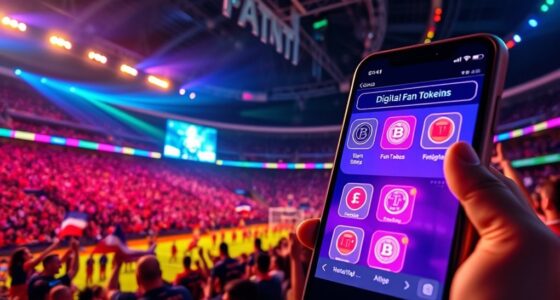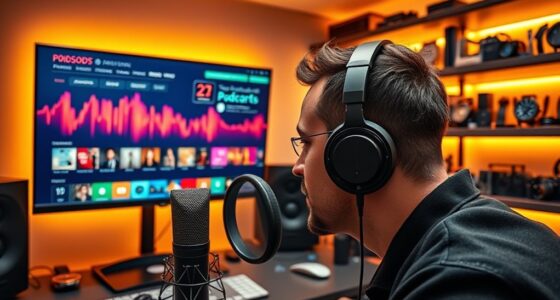During live broadcasts, your second-screen behavior involves multitasking—using devices like smartphones or tablets to share reactions, watch related content, or participate in polls. This behavior boosts engagement but can also cause distractions, reducing focus on the main event. You may seek social validation or personalized experiences through sharing photos, memes, or comments. As you explore further, you’ll discover how broadcasters and technology are shaping these interactions and creating new opportunities for viewers like you.
Key Takeaways
- Viewers increasingly use second screens to extend engagement, share reactions, and access supplementary content during live broadcasts.
- Second-screen behavior includes multitasking, commenting, sharing multimedia, and participating in polls or Q&A sessions.
- Proper etiquette and awareness of privacy risks are essential to prevent distractions and protect personal information.
- Content creators leverage second screens with interactive features to deepen viewer involvement and foster community.
- Technological innovations like AR and wearable devices enhance seamless, real-time engagement during live broadcasts.
The Rise of Multi-Device Engagement

As live broadcasts become more prevalent, viewers increasingly use multiple devices simultaneously to enhance their experience. This trend fuels the rise of multi-device engagement, where your second screen becomes an extension of what you’re watching. To navigate this, second screen etiquette guides your behavior, ensuring you stay engaged without distracting others or disrupting the broadcast. Broadcasters leverage cross platform analytics to understand how viewers interact across devices, tailoring content to boost involvement. Using smartphones or tablets during live events isn’t just about multitasking; it’s about creating a richer, more interactive experience. As a viewer, you’re part of a growing community that values seamless engagement, making your second screen use more purposeful and connected. This shift reshapes how you consume live content, emphasizing participation and real-time interaction. Additionally, understanding your content consumption habits helps you make more informed choices about your device use during broadcasts.
Motivations Behind Second-Screen Use
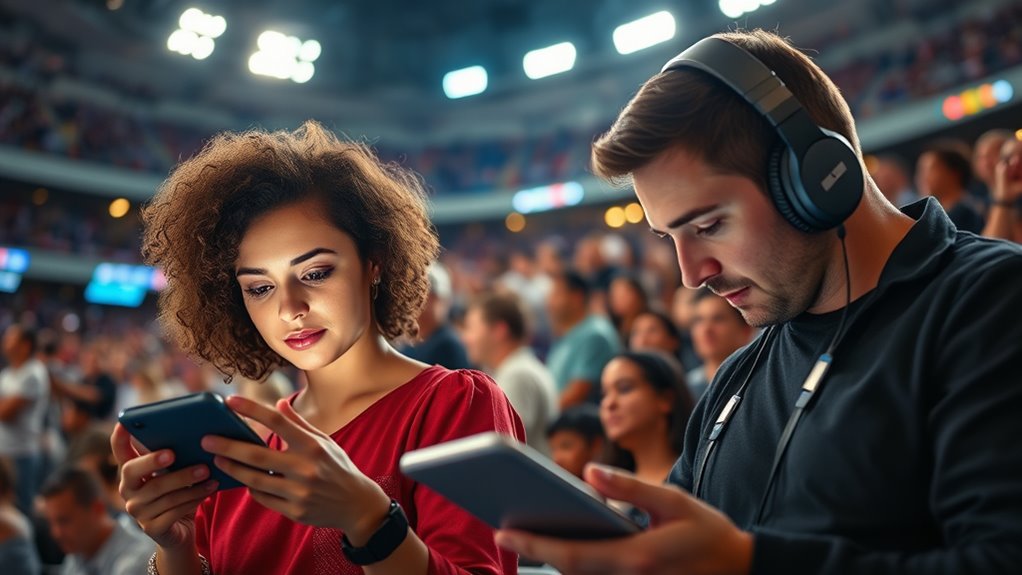
People turn to their second screens during live broadcasts to fulfill specific motivations that enhance their viewing experience. One key reason is the desire for emotional connection — engaging with others helps you feel more involved and less isolated during the event. Social influence also plays a significant role; seeing friends or online communities comment and share opinions encourages you to participate actively. By using your second screen, you can deepen your understanding of the content, react in real-time, and feel part of a larger audience. This behavior satisfies your need for social validation and belonging, making the experience more immersive and interactive. Additionally, privacy policy considerations may influence how users share their reactions and interact with content online. Ultimately, second-screen use is driven by your wish to connect emotionally and socially, enriching your overall entertainment during live broadcasts.
Types of Content Shared on Second Screens

During live broadcasts, the content shared on second screens varies widely, reflecting your motivations for staying engaged. You might post real-time comments, share memes, or tweet reactions to connect with others and express your feelings. Many users look for content that personalizes their experience, such as behind-the-scenes clips, trivia, or exclusive updates related to the broadcast. This type of content boosts user engagement by making you feel more involved and connected to the event. You also share multimedia like photos, GIFs, or short videos that capture your reactions or highlight key moments. Additionally, some users utilize anti-aging effects in their content to enhance their appearance or create a more attractive visual presentation. Overall, the variety of content shared on second screens is driven by your desire for interaction, personalization, and a sense of community during live broadcasts.
Impact on Viewer Experience and Satisfaction
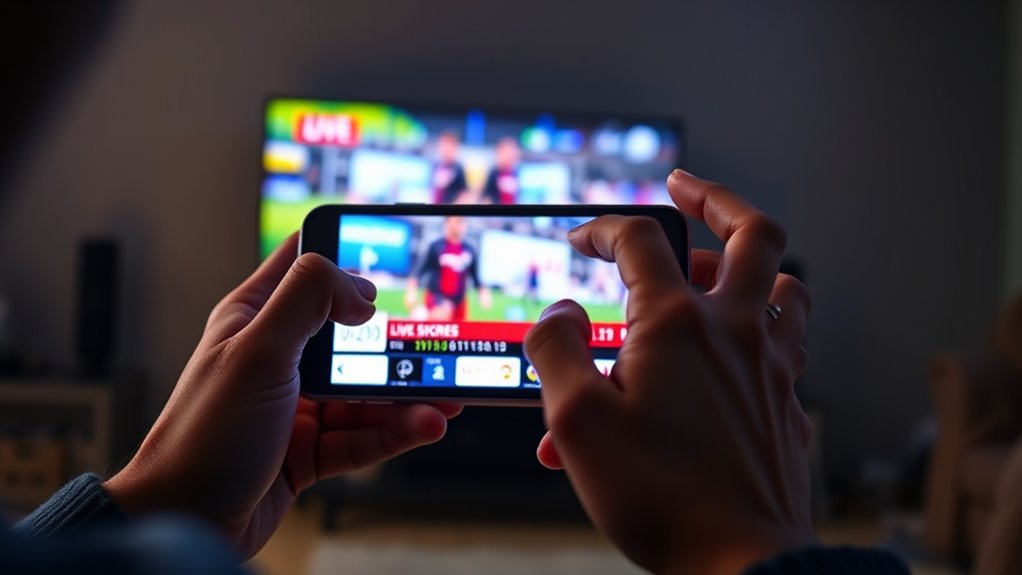
Using a second screen can increase your distraction and make it harder to focus on the main broadcast. Your engagement might spike or drop unpredictably depending on how much you’re multitasking. These behaviors can also influence how you perceive the overall quality of the live experience. Additionally, frequent switching between screens can diminish your overall attention span during the broadcast.
Distraction Levels Increase
When viewers engage with second-screen devices while watching live broadcasts, their attention often shifts away from the main content, leading to increased distraction levels. Your multitasking habits mean you’re dividing your focus, making it harder to fully process the primary broadcast. This split attention shortens your attention span, causing you to miss key moments or details. As you juggle multiple screens, your brain becomes overwhelmed, reducing overall enjoyment and comprehension. The constant switching between screens can create cognitive overload, making it difficult to stay engaged with the live content. Over time, this heightened distraction diminishes your satisfaction with the experience, as you’re less likely to remember important parts or feel truly immersed. Increasing distraction levels ultimately undermine the quality of your viewer experience.
Engagement Fluctuates Significantly
Have you noticed how your engagement with second-screen devices causes your attention to ebb and flow during live broadcasts? Mobile multitasking often leads to sudden shifts in focus, making your involvement unpredictable. These fluctuations can heighten emotional responses, as you jump between different content streams or reactions. Sometimes, you’re deeply immersed, feeling connected and excited; other times, your attention drifts away, reducing overall satisfaction. This inconsistency impacts your viewer experience, as your engagement isn’t steady. Instead, it varies based on what captures your interest at the moment. The thrill of fleeting engagement can boost short-term excitement but may also cause frustration or disconnect over time. Recognizing these fluctuations helps you understand how second-screen behaviors shape your overall perception of live broadcasts. Additionally, understanding content engagement can assist in managing your attention and enhancing your viewing experience.
Perceived Broadcast Quality
Perceived broadcast quality plays a crucial role in shaping your overall viewing experience and satisfaction. When the stream is clear, smooth, and free of interruptions, your perception of the broadcast improves, making you more engaged and satisfied. Conversely, poor quality can frustrate you and decrease your enjoyment. Your viewer perception depends not only on technical factors but also on how well the broadcast matches your expectations. The table below highlights key elements influencing perceived broadcast quality:
| Aspect | Effect on Viewer Perception | Importance |
|---|---|---|
| Video clarity | Enhances immersion | High |
| Buffering delays | Causes frustration | Critical |
| Audio quality | Affects comprehension | Essential |
| Stream stability | Builds trust | Essential |
| Resolution options | Offers control | Improves satisfaction |
Optimizing these factors directly boosts your satisfaction and engagement. Additionally, integrating security systems into your home can further enhance your overall sense of safety and peace of mind, especially when you are watching broadcasts remotely.
Strategies for Content Creators to Leverage Second Screens
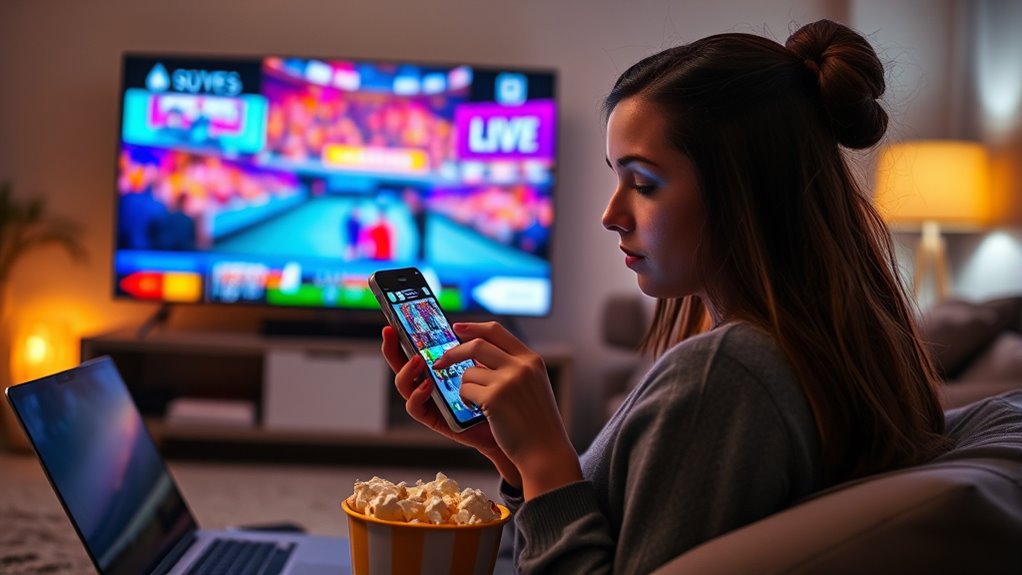
To effectively leverage second screens during live broadcasts, you must integrate interactive elements that engage viewers beyond the main feed. Focus on audience personalization by tailoring content and prompts to match viewer interests, making interactions more relevant and compelling. Use polls, quizzes, and live Q&A sessions to encourage participation, keeping viewers invested. Incorporate brand integration subtly within these activities, ensuring it enhances the experience without feeling intrusive. Offer exclusive content or behind-the-scenes glimpses accessible via second screens to foster a sense of inclusion. Clear calls to action can guide viewers to engage further. Additionally, understanding home improvement principles can inspire creative ideas for segment themes or visual setups that resonate with viewers’ interests. By blending personalized experiences with seamless brand presence, you create a more dynamic, memorable broadcast that taps into viewers’ second-screen habits effectively.
Challenges and Risks of Second-Screen Behavior
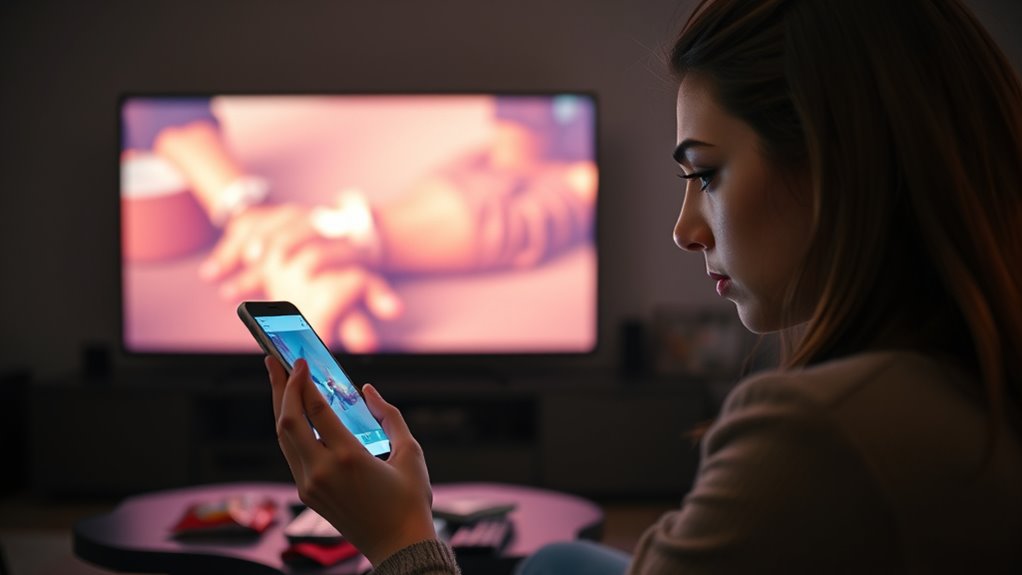
Using a second screen can split your attention and make you less focused on the live broadcast. This distraction can lead to missing important moments or details. Plus, sharing personal information or clicking on links raises privacy and security risks you should consider. Being aware of essential oil uses can help you make informed choices about your health and safety online.
Distraction and Divided Attention
Second-screen behavior can substantially distract viewers from the live broadcast, making it harder to fully engage with the content. When you multitask, your attention span gets divided, reducing your ability to focus on one task. This divided attention can lead to missed details and lower comprehension. Your multitasking habits may seem efficient, but they often compromise the quality of your engagement. To illustrate, consider this table:
| Task 1 | Task 2 | Result |
|---|---|---|
| Watching | Scrolling | Reduced focus |
| Listening | Messaging | Fragmented attention |
| Watching | Browsing | Decreased retention |
| Viewing | Commenting | Divided concentration |
Balancing your attention is key. Otherwise, you risk losing the full experience of the broadcast. Additionally, multitasking during broadcasts can diminish overall understanding and enjoyment of the content.
Privacy and Security Concerns
While multitasking on a second device can enhance your engagement, it also opens the door to privacy and security risks. You might unknowingly expose personal information or fall victim to data breaches if your device isn’t protected properly. Public Wi-Fi networks increase the chances of unauthorized access, making sensitive data vulnerable to hackers. Sharing login details or clicking on unverified links can further compromise your security. Additionally, apps and websites may collect your data without your explicit consent, risking privacy violations. To reduce these risks, use strong, unique passwords, enable two-factor authentication, and avoid sharing confidential information during second-screen interactions. Being aware of these security challenges helps you stay protected while enjoying the benefits of second-screen engagement. Understanding the importance of secure devices can further safeguard your personal information.
Technological Innovations Facilitating Second-Screen Interaction

Advancements in technology have revolutionized how you engage with live broadcasts by enabling seamless second-screen interactions. Augmented reality (AR) enhances your experience by overlaying digital content onto the real world, making interactions more immersive and engaging. For example, AR apps can provide real-time stats, polls, or interactive graphics related to the broadcast, keeping you actively involved. Wearable devices, like smartwatches and AR glasses, further streamline this process by offering quick access to updates and notifications without interrupting your viewing. These innovations make it easier to connect with content and other viewers simultaneously, creating a more integrated experience. Employing cost-effective strategies like online resources and flat-fee attorneys can also make the process of integrating new technologies more affordable. Overall, technological innovations like AR and wearable tech have transformed second-screen engagement into a dynamic, interactive component of live broadcasts.
Future Trends in Live Broadcast Engagement

As technology continues to evolve, future live broadcast experiences will become increasingly personalized and interactive. You’ll see platforms using AI to tailor content to your preferences, deepening emotional attachment. However, this personalization might also heighten second screen addiction, making it harder to focus solely on the main event. To address this, broadcasters may implement features that promote healthier engagement, like timed prompts or breaks. Here’s a glimpse of upcoming trends:
| Trend | Impact |
|---|---|
| AI-driven personalization | Boosts emotional attachment |
| Interactive polls & chats | Increases real-time engagement |
| Digital well-being tools | Reduces second screen addiction |
These advancements will redefine how you connect during broadcasts, balancing engagement with well-being. Additionally, retail hours and service schedules may influence viewer availability and interaction patterns during live events.
Frequently Asked Questions
How Does Second-Screen Behavior Vary Across Different Demographics?
You might notice that your second-screen habits differ based on demographic preferences and cultural influences. Younger audiences tend to multitask more, engaging with social media and chatting, while older viewers focus more on the broadcast itself. Cultural factors shape content choices and interaction styles, making your behavior unique compared to others. Understanding these differences helps you better connect with diverse audiences and tailor content to match varying expectations and interests.
What Psychological Factors Influence Second-Screen Engagement During Live Broadcasts?
You’re influenced by psychological factors like cognitive bias and social influence when engaging with second screens during live broadcasts. Cognitive biases, such as confirmation bias, make you seek content that aligns with your beliefs, while social influence encourages you to participate to fit in or gain social approval. These factors shape your engagement, making you more likely to interact or share content based on your perceptions and the behavior of others around you.
Are There Privacy Concerns Related to Second-Screen Interactions?
Your second-screen interactions raise serious privacy concerns, like exposing your data to third-party parties. You might not realize how much personal info is shared or how vulnerable it becomes without proper data encryption. This can lead to targeted ads or even identity theft. Always check privacy settings, make sure your data is encrypted, and be cautious about what you share, because your digital privacy is more fragile than you think.
How Do Second Screens Affect Advertising Effectiveness During Live Events?
During live events, second screens enhance advertising effectiveness through synchronized advertising and real-time engagement. You actively interact with ads on your device, making the messages more memorable and relevant. This immediate involvement boosts brand recall and encourages quick responses. When ads are tailored to your current viewing, you’re more likely to engage, leading to higher conversion rates. Overall, second screens create a dynamic environment that amplifies the impact of advertising during live broadcasts.
Can Second-Screen Habits Predict Future Media Consumption Trends?
You can use predictive modeling and trend forecasting to see if your second-screen habits hint at future media consumption. By analyzing your real-time interactions and engagement patterns, these tools can identify shifts in your preferences. This helps content creators and marketers anticipate what you’ll watch next, personalize experiences, and adapt strategies, ensuring your evolving habits shape the future of media, making it more tailored and engaging for you.
Conclusion
As you navigate live broadcasts, your second-screen interactions create a vibrant tapestry of shared moments and real-time reactions. Picture yourself immersed in the glow of your device, fueling the energy of the event around you. Embracing this dual engagement transforms passive viewing into an active, connected experience. By leveraging these moments thoughtfully, you shape the future of live entertainment—making it more interactive, dynamic, and unforgettable for everyone involved.



